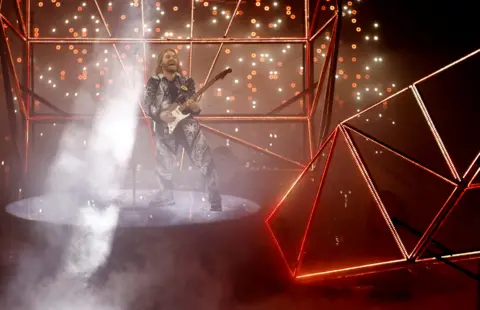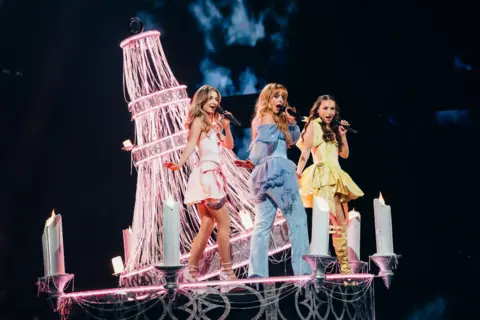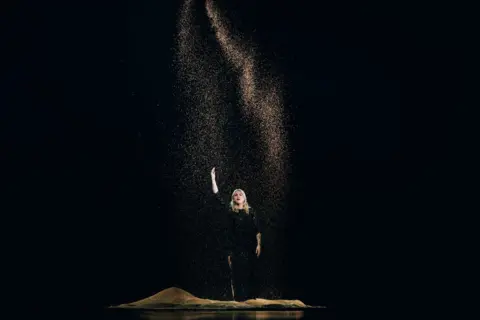his year, we’ve got disco balls, space hoppers, a magical food blender, a Swedish sauna and, for the UK, a fallen chandelier.
“It’s a big logistics effort, actually, to get all the props organised,” says Damaris Reist, deputy head of production for this year’s contest.
“It’s all organised in a kind of a circle. The [props] come onto the stage from the left, and then get taken off to the right.
“Backstage, the props that have been used are pushed back to the back of the queue, and so on. It’s all in the planning.”
‘Smuggling routes’
During the show, there are several secret passageways and “smuggling routes” to get props in and out of vision, especially when a performance requires new elements half-way through.
Cast your mind back, if you will, to Sam Ryder’s performance for the UK at the 2022 contest in Italy.
There he was, alone on the stage, belting out falsetto notes in his spangly jumpsuit, when suddenly, an electric guitar appeared out of thin air and landed in his hands.
And guess who put it there? Richard van Rouwendaal.
“I’m a magician,” he laughs. “No, no, no… That was a collaboration between the camera director, the British delegation and the stage crew.”
In other words, Richard ducked onto the stage, guitar in hand, while the director cut to a wide shot, concealing his presence from viewers at home.
“It’s choreographed to the nearest millimetre,” he says. “We’re not invisible, but we have to be invisible.”
 Reuters
ReutersWhat if it all goes wrong?
There are certain tricks the audience will never notice, Van Rouwendaal reveals.
If he announces “stage not clear” into his headset, the director can buy time by showing an extended shot of the audience.
In the event of a bigger incident – “a camera can break, a prop can fall” – they cut to a presenter in the green room, who can fill for a couple of minutes.
Up in the control room, a tape of the dress rehearsal plays in sync with the live show, allowing directors to switch to pre-recorded footage in the event of something like a stage invasion or a malfunctioning microphone.
A visual glitch isn’t enough to trigger the back-up tape, however – as Switzerland’s Zoë Më discovered at Tuesday’s first semi-final.
Her performance was briefly interrupted when the feed from an on-stage camera froze, but producers simply cut to a wide shot until it was fixed. (If it had happened in the final, she’d have been offered the chance to perform again.)
“There’s actually lots of measures that are being taken to make sure that every act can be shown in the best way,” says Reist.
“There are people who know the regulations by heart, who have been playing through what could happen and what we would do in various different situations.
“I’ll be sitting next to our head of production, and if there’s [a situation] where somebody has to run, maybe that’s going to be me!”
 Sarah Louise Beennett
Sarah Louise Beennett Sarah Louise Bennett
Sarah Louise BennettIt’s no surprise to learn that staging a live three-hour broadcast with thousands of moving parts is incredibly stressful.
This year, organisers have introduced measures to protect the welfare of contestants and crew, including closed-door rehearsals, longer breaks between shows, and the creation of a “disconnected zone” where cameras are banned.
Even so, Reist says she has worked every weekend for the past two months, while Van Rouwendaal and his team are regularly pulling 20-hour days.
The shifts are so long that, back in 2008, Eurovision production legend Ola Melzig built a bunker under the stage, complete with a sofa, a “sadly underused” PS3 and two (yes, two) espresso machines.